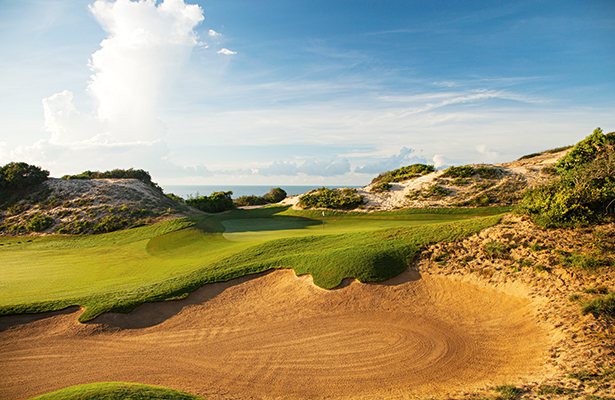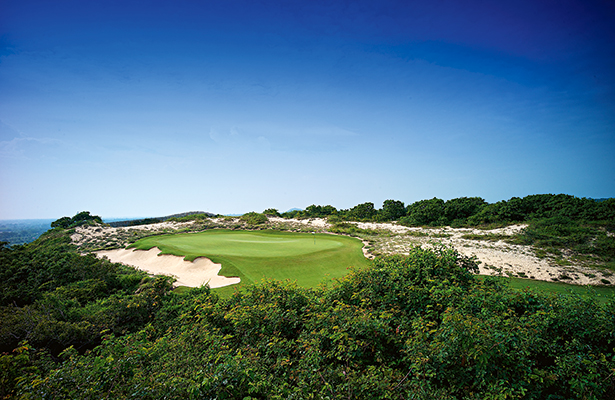Carved out of the Vietnamese sand dunes of an emerging gambling mecca is The Bluffs Ho Tram Strip by Greg Norman.
The great golf course boom of the western world may be behind us but it has done little to dent the enthusiasm of Aussie icon Greg Norman. The Great White Shark has turned his attention east, paving a bold new wave of golf course development in communist Vietnam.
Situated on the Ho Tram Strip about two-and-a-half hours south-east of Ho Chi Minh City, Norman’s latest design, The Bluffs, officially opened for play late last year amid much fanfare. The course occupies a large sandy stretch of duneland overlooking what the Vietnamese call The East Sea. Ho Tram itself is a small, third world beach town with much of the surrounding area left undeveloped and rural. The Strip region, however, has been earmarked as a ‘mini-Las Vegas’ gambling precinct, and already boasts a lavish, five-star, 500-plus room hotel and casino, with more planned for future development, along with upscale residential estates and luxury oceanside condominiums.
As with the previous Norman course in Vietnam, outside the port city of Danang, Norman’s company was given sandy soil and a prime beachside site at Ho Tram, with a development caveat that prevented the golf being routed directly alongside the water.
Here the golf was pushed on the inland side of The Strip road, with the chief difference to Danang being steeper dunes allowed for seaside views from many points on the course.
Unquestionably, both would have benefitted from a more golf-friendly overall masterplan, but the reality of development in this part of the world is very different to established markets like Australia. That said, what Norman’s team has produced in Vietnam is impressive and worthy of closer inspection.
Returning to familiar waters
The first Greg Norman course to open in Vietnam was the Dunes at Danang Golf Club, designed by Australian architect Harley Kruse. Danang is far less undulating and exposed than The Bluffs, but much better routed with the course walkable and holes transitioning very easily between greens and tees. They also change direction more frequently. The principal attraction here is the par-3 16th hole, which heads towards – and tantalisingly close to – China Beach, made famous during the Vietnam War as an airbase for American soldiers. The 16th is certainly a beautiful hole, but there are other charmers across the layout as well. The seventh from the regular tees, for example, is a lovely, drivable par 4, while the eighth appears to pay homage to a famous par 3 on the East Course of Royal Melbourne – its green completely ringed by sand that eats attractively into the putting surface.
Kruse and his shaper, fellow Australian Peter Waddell, did a fine job with the shaping at Danang, cutting sprawling bunkers out of the native sand and vegetation and building a number of smart, believable green sites. Some of the steps and rolls are quite dizzying, but saddle-style targets at the third and seventh are great fun, as is the green on the par-5 12th, pushed right up against a surrounding sandy waste.
Surprisingly, the greens at The Bluffs are even more adventurous than those at Danang. Norman’s Asian design team had completely changed by the time The Bluffs project came to be built, and credit must go to the American design associates who worked on this project for creating a diverse, fun and attractive set of green complexes. Elevated targets like the fourth, seventh and 10th probably take the top pictures here, but the best are arguably the more subtle greens set down on the ground, if only because they are less penal in the frequent high winds. The design and shaping teams also deserve credit for the sculpting of some expansive dune bunker complexes and for the decision to leave vast areas of short cut grass. It appears that Bill Coore’s Shanqin Bay course, on nearby Hainan Island, might have influenced this decision, with some of the rugged bunkers and shared fairways resembling areas on that recently completed, and highly rated, Chinese gem.
Whatever the influence, golfers tackling The Bluffs are certain to drive off the 18th green with several strong memories of the completed round. Among them are back-to-back par 3s at the fourth and seventh, with their shared teeing ground, and the brave triple-depression punchbowl green on the fun par-4 eighth. The horseshoe green site and central bunker on the uphill 14th is also appealing, as is the par-5 16th, with a shared fairway that in parts must measure in excess of 200 metres wide. The challenge here is not finding short grass off the tee, but instead positioning your subsequent shot near enough the secondary bunkers to leave a reasonable approach to a cleverly contoured green site. Between an upper left ledge and a lower right hollow are some of the most interesting, and exacting, putting undulations on the course.
“This course has all the elements necessary to be ranked among the best in the world,” says Ben Styles, general manager of The Bluffs Ho Tram Strip.
Save your legs
The most obvious knock on The Bluffs is the routing, which doubles back on itself in a couple of spots and gets so steep in places to essentially become unwalkable. It’s unlikely that resort guests will mind much, given they will almost exclusively be playing in golf carts. The flow and rhythm of the round, however, does suffer because of the interruptions between greens and tees and is something that will frustrate the purists.
During the gala opening event, Norman confirmed that his team originally had a couple of holes designed down on the water, but had been asked to shift them inland because of future development. This decision might explain some of the subsequent routing problems at The Bluffs, along with a design mentality to squeeze as much excitement as possible into the layout.
Regardless, The Bluffs is a thrill-fest from start to finish and one would expect that green-fee golfers will enjoy the experience and be impressed by the drama of the site, the views, the bunkering and the greens. Although the strong local winds make it a more difficult course than Danang in many ways, from the tee The Bluffs is quite straightforward – thanks to its generous driving zones and the fact that the best play on most holes is to simply smash your drive down the middle. Approach play is more fraught, but neither course was created to terrorise from the regular tees and those who enjoy golf in southeast Asia, and aren’t obsessed by their own scores, are almost certain to be impressed.
People holiday for all sorts of reasons, and choose their destinations based on a whole host of factors. Golfers are no different. If it’s pure golf you want on a classic links environment with fine-bladed grasses and a bouncing ball, you go to the UK or Ireland, or stick to southeast Australia. Golfers heading for the tropics, however, are looking for something else. They’re looking for delicious food, kind people, meaningful history, pristine beaches and, most of all, quality golf. Vietnam – and The Bluffs – offers all that within a relatively undisturbed paradise. Give it a go.
THE BLUFFS
Ho Tram Strip
Green fees from $110
thebluffshotram.com
HOTEL – THE GRAND HO TRAM STRIP (★★★★★)
thegrandhotramstrip.com
DANANG GOLF CLUB
Green fees from $120
dananggolfclub.com






